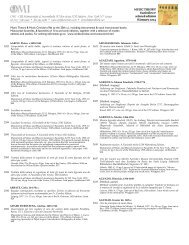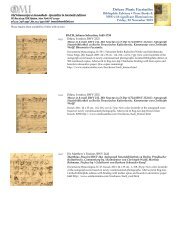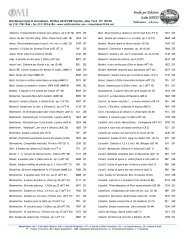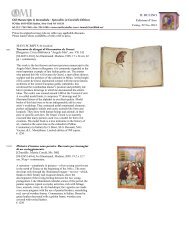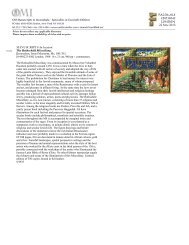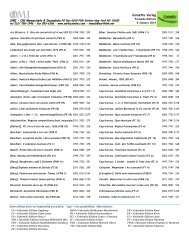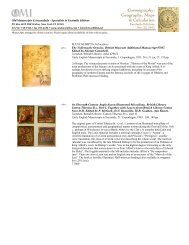MLA Chicago â 2009 OMI - Old Manuscripts & Incunabula PO Box ...
MLA Chicago â 2009 OMI - Old Manuscripts & Incunabula PO Box ...
MLA Chicago â 2009 OMI - Old Manuscripts & Incunabula PO Box ...
You also want an ePaper? Increase the reach of your titles
YUMPU automatically turns print PDFs into web optimized ePapers that Google loves.
<strong>OMI</strong> - <strong>Old</strong> <strong>Manuscripts</strong> & <strong>Incunabula</strong> <strong>PO</strong> <strong>Box</strong> 6019 FDR Station, New York, NY 10150<br />
tel 212/ 758-1946 • fax 593-6186 • http://www.omifacsimiles.com • immels@earthlink.net<br />
<strong>MLA</strong> <strong>Chicago</strong> — <strong>2009</strong><br />
Facsimiles and<br />
selected editions<br />
displayed on Table<br />
BACH, Johann Sebastian, 1685-1750<br />
9030 [Art of Fugue, BWV 1080]<br />
Die Kunst der Fuge / L’arte della fuga BWV 1080. Studio introduttivo a<br />
cura di Sergio Vartolo.<br />
Archivum Musicum: Monumenta Musicae Revocata, 37. Florence, 2008. 24 x<br />
34 cm, 4 vols, 99, 40, 72, 20 pp. Line-cut of the autograph score and the<br />
beautifully engraved first edition issued 1751/1752. Introduction in It by<br />
Sergio Vartolo, with abstract in English. Wrappers, with portfolio in cloth and<br />
decorative paper. $128<br />
BIBER, Heinrich Ignaz Franz von, 1644-1704<br />
9028 [Sonatas, violin, bc, “Mystery Sonatas”]<br />
Rosenkranz-Sonaten. Bayerische Staatsbibliothek München, Mus. Mss<br />
4123. Vorgelegt von Manfred Hermann Schmid. [Im Anhang:] Faksimile<br />
der “Türken-Sonate” aus dem Kodex Ms XIV 726 (Nummer 80, Bll. 162r<br />
bis 163v) des Wiener Minoritenkonvents].<br />
Denkmäler der Musik in Salzburg, Faksimile-Ausgaben, 14. Munich, 2008.<br />
Oblong, 30 x 22 cm, 86, xxx, 4 pp + 1 foldout. New color reproduction of the<br />
magnificent presentation copy (non autograph, sole surviving source),<br />
dedicated to the Archbishop Maximilian Gandolph von Khuenberg. These<br />
fifteen wonderful sonatas, abstract commentaries on biblical incidents<br />
traditionally grouped into three groups of five—Joyful (his early life),<br />
Sorrowful (his passion), Glorious (his ressurection)—are noteworthy for their<br />
use of scordatura and their powerful preludes. They originally were<br />
performed in the lecture hall “Aula Academica” of Salzburg University,<br />
which still contains fifteen paintings depicting the mysteries. In like manner<br />
biblical illustrations—small engraved medallions—were glued in the<br />
manuscript at the beginning of each piece. The work ends with the<br />
passacaglia for solo violin, one of the most beautiful and soaring pieces of the<br />
German baroque. This new facsimile edition importantly includes a facsimile<br />
of a concordance of the tenth sonata (from MS XIV 726, Wiener<br />
Minoritenkonvents) — ”Türken-Sonate”—where the same music has<br />
programmatic titles: “Der Türcken Anmarch”, “Der Türcken Belägerung der<br />
Stadt Wien”, “Der Türcken stürmen”, “Anmarsch der Christen”, “Treffen der<br />
Christen”, “Durchgang der Türcken”, “Victori der Christen”. In Ms XIV 726, a<br />
composite source of violin music by Biber, Schmelzer and others, the scribe<br />
attributes the Türken-Sonate to “Schmelzer”. Introduction in Ger. Cloth. $179<br />
http://www.omifacsimiles.com/brochures/biber_ms2.html<br />
CHOPIN, Frédéric, 1810-1849<br />
9022 [Mazurka, piano, op.59,2/Kob.796]<br />
Mazurek Op.59 nr 2 / Mazurka, Op.59, No.2. Wydanie faksymilowe<br />
rękopisu ze zbiorów Biblioteka Opery, Paryż (Rès. 50[1] ). Facsimile<br />
Edition of the Manuscript Held in the Library of the Paris Opera (Rès.<br />
50[1]).<br />
Works by Chopin—Facsimile Edition, [11] A /IV/59/2. Warsaw, 2008.<br />
Oblong, 28 x 22 cm, 2 vols, 5, c.60 pp. Full-color halftone of the autograph<br />
sketch. Commentary (Pol-Eng-Ger-Sp-Fr-Jp) by Jim Samson. Bound in blue<br />
linen, with matching slipcase. $88<br />
http://www.omifacsimiles.com/brochures/chop_maz59,2.html<br />
DEBUSSY, Claude, 1862-1918<br />
9013 Images pour piano, 1re serie.<br />
Fac-similes de Manuscrits de Claude Debussy. Paris, 2008. 27 x 35 cm, 36 pp.<br />
4-color facsimile of the autograph. Wrappers, in beautiful art paper. $148<br />
http://www.omifacsimiles.com/brochures/debussy_img.html<br />
9014 Images pour piano, 2e serie.<br />
Fac-similes de Manuscrits de Claude Debussy. Paris, 2008. 27 x 35 cm, 40 pp.<br />
4-color facsimile of the autograph. Wrappers, in beautiful art paper. $148<br />
http://www.omifacsimiles.com/brochures/debussy_img.html<br />
HANDEL, George Frideric, 1685-1759<br />
8998 [Messiah, oratorio, HWV 56, autograph]<br />
Messiah HWV 56. Autograph. The British Library London. Commentary<br />
by / Kommentar von Donald Burrows.<br />
Documenta Musicologica, II/40. Kassel, 2008. 4°, viii, 284, 56 pp. Full-color<br />
facsimile edition of the autograph score, issued on the occasion of the 250th<br />
anniversary of the composer's death. Commentary in Eng-Ger-Jap. Handsome<br />
bibliophile binding with linen spine and decorative paper boards. Special<br />
<strong>OMI</strong> price. $499<br />
http://www.omifacsimiles.com/brochures/handel_mess.html<br />
HAYDN, Franz Joseph, 1732-1809<br />
9010 [Symphony, no.45, “Farewell”, F sharp major, Hob.I:45]<br />
Sinfonie Nr. 45 “Abschiedssinfonie”<br />
Faksimile nach dem Autograph in der Nationalbibliothek Budapest. Mit<br />
einer Einleitung (deutsch/englisch) von Armin Raab.<br />
Meisterwerke der Musik im Faksimile, 11. Laaber, 2008. 26 x 41 cm, xvi, 57 pp.<br />
Full-color facsimile of the autograph score issued on the occasion of the<br />
bicentenary of the composer’s death. Commentary in Ger-Eng. Hardbound in<br />
decorative paper. Special subscription price valid until 12/31/08. $120<br />
9011<br />
[Symphony, no.102, Bb major, Hob.I:102]<br />
Sinfonie Nr. 102 (”London”)<br />
Faksimile nach dem Autograph in der Staatsbibliothek Berlin. Mit einer<br />
Einleitung (deutsch/englisch) von Armin Raab.<br />
Meisterwerke der Musik im Faksimile, 12. Laaber, 2008. 26 x 41 cm, xvi, 57 pp.<br />
Full-color facsimile of the autograph fair copy composed in 1794 for Haydn's<br />
second London visit. Scored for 2 fl, 2 ob, 2 bsn, 2 hn, 2 tpt, timp, & strings, the<br />
work has all the stylistic hallmarks of the late Haydn symphony with its<br />
masterly confluence of simplicity and complexity, folkishness and<br />
sophistication. There is also the element of thematic surprise as well as<br />
orchestral excitement (the drumroll that ushers in the recapitulation in the<br />
first movement) and outrageous wit, shown by the violins getting "stuck" on a<br />
phrase in the finale and unable to remember what comes next. A fitting<br />
tribute for the celebration of the bicentenary of the composer’s death.<br />
Commentary in Ger-Eng. Hardbound in decorative paper. $110<br />
http://www.omifacsimiles.com/brochures/haydn_102.html<br />
9012 [Variations, piano, F minor, Hob.XVII:6]<br />
Variationen F-moll (Sonate) Hob. XVII:6. Introduction: Armin Raab.<br />
[New York Public Library, New York].<br />
[Henle Music Facsimiles, 20]. Munich, 2008. 4°, ca. xiv, 8 pp. Deluxe color<br />
facsimile of the autograph issued on the occasion of the bicentenary of the<br />
composer’s death. Four leaves contain the fair copy of the work, while two<br />
leaves represent a composing copy. Originally entitled “Sonate for Signora de<br />
Ployer” (probably the pianist Barbara Ployer, a piano and composition pupil<br />
of Mozart), the variation movement was apparently intended as the beginning<br />
of a sonata with several movements. As can be seen from the second part of<br />
the autograph score, Haydn later extended the movement, ending it with an<br />
expansive Capriccio Coda. The first printed edition already bears the title<br />
“Variations”. The moving masterpiece has been played all over the world as<br />
“Variations in f minor” ever since. Commentary in Ger-Eng. Wrappers, in<br />
decorative paper. $90<br />
HUBERTY, Anton, c.1722-1791<br />
8953 [Method, viola d’amore]<br />
Neu Method-Messige Viol d’amore Stüke. Wien. Mit einem Kommentar<br />
und Inhaltsverzeichnis von Marianne Rônez. [Sibley Library, Rochester,<br />
NY].<br />
Faksimile-Edition Rara, 56. Stuttgart, 2008. Oblong, 25 x 18 cm, 3 vols, 220, 23<br />
pp. Line-cut of the Vienna, c.1790 edition, based on the unique copy preserved<br />
in the Sibley Library. This rare and fascinating publication, by a professional<br />
double bass player and publisher, offers a treatise on the viola d’amore,<br />
together with a rich collection of music: genre pieces (short dances or<br />
character pieces), 9 sonatas, 1 duo, pieces with bc accompaniment, pieces with<br />
voice. Introduction in Ger-Eng. Hardbound in decorative paper, with<br />
handsome slipcase. $165<br />
JELIC, Vinco, 1596-1636<br />
9031 Parnassia militia [Concertuum unius, duarum, trivum et quattor vocum<br />
tam nativis quam instrumentalibus vocibus, ad organum concinendarum.<br />
Opus primum], Straßburg, Paul Ledertz 1622. [Universitätsbibliothek<br />
Frankfurt].<br />
Faksimile-Edition Canto e Continuo, 5. Stuttgart, 2008. 16 x 22 cm, 5<br />
partbooks, 220 pp. Line-cut of the Strasbourg, 1622 partbooks (cantus, altus,<br />
tenor, bassus, bassus ad organum). Collection of 24 motets for 1 to 4 voices,<br />
plus 4 ricercare for cornetto/violin, trombone/viol & bc). Wrappers, with<br />
portfolio. $61<br />
KAPSBERGER, Johann Hieronymus, c.1575-c.1640<br />
9008 [Intabulations, archlute, book 3]<br />
Intavolatura di chitarrone. Libro 3. Introduction by Franco Pavan.<br />
Bibliotheca Musica Bononiensis, IV/83. Bologna, 2008. 4°, 60 pp. Line-cut of<br />
the Rome, 1626 edition. Wrappers. (expected April <strong>2009</strong>)
O M I — tel. 212/ 758-1946 • fax 212/ 593-6186 • http://www.omifacsimiles.com • immels@earthlink.net p.2<br />
MENDELSSOHN-BARTHOLDY, Felix, 1809-1847<br />
9009 [Concerto, violin, orch, op.64, E minor]<br />
Violinkonzert e-Moll. Faksimile nach dem Autograph der Bibliothek der<br />
Jagiellonen-Universität Krakau. Mit einer Einleitung (deutsch/englisch)<br />
von Stefan Drees.<br />
Meisterwerke der Musik im Faksimile, 10. Laaber, 2008. Oblong, 29 x 22 cm,<br />
xx, 69 pp. Full-color facsimile of the autograph score dated 16 September 1844.<br />
Mendelssohn's popular "Concerto for Violin in E Minor op.64", a mainstay in<br />
the concerto repertoire didn't have an easy birth and is known in two<br />
versions, the sole surviving autograph of 1844—reproduced here in<br />
facsimile—and the printed edition of 1845, a more brilliant version<br />
incorporating many of the changes suggested by Ferdinad David, dedicatee of<br />
the piece and his concertmaster at Leipzig. On July 30, 1838, the composer<br />
wrote to him: "I would like to write a violin concerto for you next winter. One<br />
in E minor goes through my head and the beginning will not leave me in<br />
peace." David encouraged Mendelssohn but also expressed a desire for it to be<br />
ostentatious, a suitable showcase for the violinist's talents. Mendelssohn was<br />
not used to flamboyance for its own sake and this wish conflicted with his<br />
musical temperament, prolonging the writing of the concerto. More than six<br />
years later with only three months before it was to be performed he confided<br />
to David: "Do not laugh at me too much. I feel ashamed in any case, but I<br />
cannot help it. I am just groping around." It was finally premiered on 13<br />
March 1845 and published shorly thereafter by Breitkopf & Härtel. There are<br />
well over 100 changes between the two versions, mostly issues concerning<br />
tempo, orchestration, and solo parts. While some are outright shocking, where<br />
Mendelssohn has taken in the final version the solo line up or down an octave,<br />
added entirely new notes to the violin part, or slightly changed the wind<br />
writing, no matter which version is considered both are pure Mendelssohn,<br />
and all the magical elements that make the Violin Concerto what it is, that<br />
make it so beloved and so popular, are completely intact. Commentary in<br />
Ger-Eng. Linen. Issued on the occasion of the bicentenary of the composer’s<br />
birth. Special subscription price valid until 12/31/08. $210<br />
http://www.omifacsimiles.com/brochures/mendel_vc.html<br />
9033<br />
[Overture, A Midsummers Night’s Dream]<br />
The Overture to A Midsummer Night’s Dream. Facsimile of the<br />
Autograph Score in the Biblioteka Jagiellońska, Krakow. Edited by<br />
Friedhelm Krummacher.<br />
Documenta Musicologica, II/41. Kassel, <strong>2009</strong>. 4°, 60, 12 pp. Full-color<br />
facsimile edition of the 1826 autograph score, issued on the occasion of the<br />
200th anniversary of the composer's birth. Commentary in Eng-Ger-Jap.<br />
Handsome bibliophile binding with linen spine and decorative paper boards.<br />
Special <strong>OMI</strong> price. (to appear April <strong>2009</strong>) $426<br />
http://www.omifacsimiles.com/brochures/mendel_mid.html<br />
MONZANI, Tebaldo, 1762-1839<br />
9056 [method, flute]<br />
Instructions for the German Flute. London s.d.; New and Enlarged Edition<br />
of Monzani’s Instructions for the German Flute. London s.d.<br />
Archivum Musicum: Ottocento, 2. Florence, 2008. 24 x 34 cm, 2 vols, x, 50, 72<br />
pp. Line-cut of the London, [1801] and London, [1819] editions. Preface in It<br />
by Marcello Castellani. Wrappers, in decorative paper with matching<br />
portfolio. $78<br />
MOZART, Wolfgang Amadeus, 1756-1791<br />
9043 [Adagio, glass harmonica, K.356 (617a)]<br />
L’autografo dell’ Adagio KV 356 per Glasharmonika nella Bibliothèque<br />
Nationale de France di Parigi (Départment de la Musique, Sammlung Ch.<br />
Maherbe, Signatur: Ms. 220). A cura di Giacomo Ferrari.<br />
Lucca, <strong>2009</strong>. 23 x 33 cm, xvi, 2 pp. Color facsimile of the autograph issued on<br />
the occasion of the 250th anniversary of the composer’s birth. Commentary in<br />
It-Eng-Ger. Portfolio. $88<br />
PHALÈSE, Pierre, c.1510-1574 [publisher]<br />
9025 Selectissima elegantissimaque guiterna carmina.<br />
Lübeck, 2008. 4º, 160 pp. Line-cut of the Lyon & Antwerp, 1570 edition.<br />
Important anthology of music for 4-course Renaissance guitar comprising<br />
fantasies galliards, almains, branles, songs and motets from France and Italy,<br />
c.250 works in all. French tablature. Wrappers. $44<br />
SCHMELZER, Johann Heinrich, 1620-1680<br />
9050 [Sonatas,violin, bc]<br />
6 Sonatae unarum fidium. Herausgegeben von Marc Strümper.<br />
Magdeburg, <strong>2009</strong>. 4º. Line-cut of the Endter edition, Nuremberg, 1664. The<br />
first collection of violin sonatas published by a German-speaking composer<br />
and a milestone in the history of violin music. The first 6 sonatas are in<br />
variation form; the last two introduce dance movements with wonderful<br />
ruminative monologues. Wrappers. $40<br />
VIVALDI, Antonio, 1678-1741<br />
8993 [Works, selections, viola da gamba & other instruments]<br />
Opere per viola all’inglese (viola da gamba). Recitativo e aria con<br />
“Concerto de’ Viole all’Inglese” da Juditha Triumphans, RV 644; Cantata<br />
in Scena con Viola all’Inglese de L’Incoronazione di Dario, RV 719;<br />
Concerto Funebre in Si bemolle maggiore, RV 579; Concerto con molti<br />
Istromenti in Do maggiore, RV 555. A Cura di Bettina Hoffmann.<br />
Archivum Musicum: Vivaldiana, 4. Florence, 2006. Oblong, 30 x 24 cm, 43, 83<br />
pp. Halftone of 4 autograph scores that include music for viola da gamba.<br />
Introduction in It-Eng. Wrappers, in decorative paper. $86<br />
COM<strong>PO</strong>SITE & MISCELLANEOUS SOURCES<br />
8908 [Bologna, Museo Internazionale e Biblioteca della Musica, Cod. Q15]<br />
Bologna Q15: The Making and Remaking of a Musical Manuscript.<br />
Introductory Study and Facsimile Edition by Margaret Bent. Volume I:<br />
Introductory Study. Volume II: Facsimile.<br />
Ars Nova, Nuova Seria, 2. Lucca, 2008. 24.5 x 32.5 cm. 2 vols, 400, 686 pp. This<br />
manuscript is the largest international anthology of polyphonic music of the<br />
early 15th century. It was compiled in Padua in the early 1420s (stage I) and<br />
Vicenza in the early 1430s (stages II-III), all copied by a single scribe. The three<br />
illuminations are an unusual luxury for a musical manuscript at this period. It<br />
was acquired by Padre Martini in 1757 and is a major treasure of his library in<br />
Bologna. About half of its 323 compositions are unique; some others are<br />
shared with and complemented by the slightly younger Veneto manuscripts<br />
Bologna, Biblioteca Universitaria 2216 and Oxford, Canon. misc. 213. It is the<br />
most important source for the works of Zacara and Ciconia and for the early<br />
works of Guillaume Du Fay (with 78 works, many of them unica). About 50<br />
composers are represented, including native Italians, and composers from the<br />
north who were sought after and made their careers in Italy. It is primarily a<br />
collection of mass movements (mostly Glorias and Credos, and a few cycles)<br />
and motets. Du Fay's Missa Sancti Jacobi was assembled as a cycle only here,<br />
and can now be linked with the humanist circle around the Venetian patrician<br />
bishop Pietro Emiliani of Vicenza, in which Q15 was compiled. The 109<br />
motets include compositions in honour of doges, bishops and noblemen. 19<br />
French songs were added at the end of stage I, and 11 laude at stage III. Other<br />
late additions are the cycle of 24 hymns (most by Du Fay), 9 Magnificats and 3<br />
sequences. For the first time, the complex codicological history of this<br />
manuscript is unravelled and the importance of its many revisions examined.<br />
The first compilation was originally much larger; the manuscript now<br />
embodies two overlapping, superimposed anthologies. Margaret Bent tells<br />
this story in her extensive introductory study, which also includes<br />
comprehensive indexes and catalogues. She spells out some of the conclusions<br />
to be drawn from the partial destruction of the manuscript by its own creator,<br />
a unique and extraordinary testimony to changing taste and contemporary<br />
reception. Deluxe limited edition, supplied with slipcase. $1425<br />
http://www.omifacsimiles.com/brochures/bologna_q15.html<br />
8503<br />
6685<br />
[Chantilly, Bibliothèque du Château de Chantilly, ms. 564 (olim<br />
1047)]<br />
Codex Chantilly. Bibliothèque du Château de Chantilly, Ms. 564.<br />
Fac-similé. Edité par Yolanda Plumley & Anne Stone. Centre d’Études<br />
Supérieures de la Renaissance.<br />
Collection “Epitome Musical”. Turnhout, 2008. 29 x 40 cm. x, 164; 211 pp.<br />
Full-color facsimile in the original format. Exciting late medieval source with<br />
99 songs and 13 motets, 61 of them unique. These works include some of the<br />
most elaborate surviving examples of the “Ars subtilior” notation, known for<br />
its experimentation in music rhythm. The provenance of this complex ms is<br />
still in dispute, being either 14th century southern France or an early 15th<br />
century Italian copy of a French repertoire. The basic corpus dates from<br />
c.1350-95; the ars subtilior repertoire by papal singers from Avignon and<br />
musicians employed at the Foix and Avignon courts is slightly later.<br />
Composers include Solage, Philippus de Caserta, Trebor, Vaillant, Machaut,<br />
Senleches, Susay, Cordier, Magister Franciscus, and Hasprois. The ms was<br />
owned by a Florentine family (possibly commissioned by them) and remained<br />
in Florence until 1861, at which time it was brought to Chantilly by the Duke<br />
of Aumale. Commentary in Fr-Eng. Handsome binding in black linen with<br />
dust jacket. $350 http://www.omifacsimiles.com/brochures/chantilly.html<br />
[Chantilly, Bibliothèque du Château de Chantilly, ms. 564 (olim<br />
1047)]<br />
A Late Medieval Songbook and its Context: New Perspectives on the<br />
Chantilly Codex (Bibliotheque du Chateau de Chantilly, Ms. 564), edited<br />
by Yolanda Plumley and Anne Stone.<br />
Collection “Epitome Musical”. Turnhout, 2008. 29 x 40 cm. 365 pp.<br />
Proceedings for a special symposium devoted to Codex Chantilly. Wrappers.<br />
$100 http://www.omifacsimiles.com/brochures/chantilly.html
O M I — tel. 212/ 758-1946 • fax 212/ 593-6186 • http://www.omifacsimiles.com • immels@earthlink.net p.3<br />
9015 [Milan, Biblioteca dell’Università Cattolica del S. Cuore, ms. catt. 5]<br />
L’“Antiphonarium letaniarum” ambrosiano del 1492. A cura di Giacomo<br />
Baroffio e Eun Ju Kin e una presentazione di Ellis Sada.<br />
Bibliotheca Mediaevalis, 1 Lucca, 2008. 20.5 x 28 cm, xxxiii, 150 pp. Deluxe<br />
full-color reproduction of a late 15th-c. Ambrosian processional. This<br />
beautifully executed "Antiphonale of the Litanies" in characteristic Ambrosian<br />
script was acquired by Catholic University of the Sacred Heart in 1970, gift of<br />
Father Oblati di Rho. It contains the antiphons of the Rogation week according<br />
to the Milanese ritual, a complex liturgical intinerary celebrated on Monday,<br />
Tuesday and Wednesday after Ascension, that is, at the beginning of the week<br />
preceeding Pentecost. The liturgy provided the singing of the antiphons<br />
during the processional itinerary where both congregation and clergy<br />
participated. The procession lasted 3 days and went to 30 churches; 13<br />
churches during the first day and 11 and 12 (or 14) the following days. The<br />
book was written in 1492 by Antonio de Lampugnano, commissioned by<br />
Cristoforo de Camponibus, a canon of S. Maria della Scala. The later provided<br />
to include the music according to the canonic calligraphy of the gothic<br />
Lombard notation used exclusively in the liturgical Ambrosian books. The<br />
only historiated miniature, at the beginning of the litanies, shows St.<br />
Ambrosio seated with the mitre and pallium. Two miniatures signal the<br />
beginning of the second and third days of the litanies. The topographic index<br />
confirms the local character of the chants. The majority of them are<br />
transmitted solely in the books of the Ambrosian rite; few are common with<br />
the Roman tradition and probably derived from it. Hardbound. $308<br />
http://www.omifacsimiles.com/brochures/proc.html<br />
8927<br />
[Paris, Bibliothèque Nationale, Rothschild 2973]<br />
Le chansonnier de Jean de Montchenu.<br />
Valencia, 2007-2008 Heart shaped, 22 x 16 cm, 144 pp + commentary. This<br />
exceptional MS, closed, is shaped like a heart; it opens into the shape of a<br />
butterfly composed of the hearts of the two lovers who send love messages to<br />
one another in each one of the songs. When the word “heart” appears in the<br />
texts, it is represented by a pictogram. Two full-page illustrations appear in<br />
the codex. In the first, Cupid throws arrows at a young girl while at his side<br />
Fortune spins his wheel. In the other, two lovers approach one another<br />
lovingly. Throughout the MS the pentagrams, music and love poems are<br />
surrounded by borders made up of animals, birds, dogs, cats and all kinds of<br />
flowers and plants highlighted in abundant and delicate gold. The book gets<br />
its name from Jean de Montchenu, a nobleman, apostolic prothonotary,<br />
Bishop of Agen (1477) and later of Vivier (1478-1497) who commissioned the<br />
work. The music repertoire consists of French and Italian songs written by<br />
Dufay, Ockeghem, Busnois and their contemporaries. Limited edition of 1380<br />
copies bound in red velet after the original; 2-part slipcase covered in green<br />
leather. http://www.omifacsimiles.com/brochures/montchen.html<br />
MODERN EDITIONS<br />
6727 Weill, Kurt (collected edition)<br />
Zaubernacht. Edited by Elmar Juchem and Andrew Kuster.<br />
The Kurt Weill Edition, I/0. New York, 2008. 30 x 39 cm. Zaubernacht is an<br />
hour-long stage work scored for an imaginative 9-piece ensemble consisting of<br />
flute, bassoon, percussion, piano and 5 string players. Weill composed this<br />
children's pantomime in 1922, while he was a member of Ferruccio Busoni's<br />
master class in composition in Berlin. Based on a scenario by Wladimir<br />
Boritsch (1891–1954), an elusive writer and impresario from Russia, the<br />
pantomime received its world premiere on 18 Nov. 1922 at Berlin's Theater<br />
am Kurfürstendamm. The work's only other production occurred at New<br />
York City's Garrick Theatre in December 1925, after which the orchestration<br />
disappeared. After 80 years of obscurity, Kurt Weill’s first stage work is<br />
available again in this critical edition thanks to the rediscovery of the original<br />
set of instrumental parts at Yale University in 2006. Cloth. (Subscribers to the<br />
series receive ca.33% discount). $340<br />
http://www.omifacsimiles.com/brochures/weill.html<br />
MONOGRAPHS<br />
6686 [Alamire Foundation]<br />
Yearbook of the Alamire Foundation 6. [Proceedings of “Bruges-Venice:<br />
Music in Two Urban Mosaics”, Bruges, 14-16 December 2001; and part I<br />
of the 17th International Congress of the International Musicological<br />
Society, Leuven, 1-7 August 2002].<br />
Leuven-Neerpelt, 2008. 8º, 432 pp. Contents - Mary E. Wolinski: Drinking<br />
Motets in Medieval Artois and Flanders; Julie E. Cumming: From Variety to<br />
Repetition: The Birth of Imitative Polyphony; Eric Rice: The Role of Acoustics<br />
in the Performance of Renaissance Polyphony at the Collegiate Church of<br />
Saint Mary in Aachen; Katelijne Schiltz: Polyphony and Word-Sound in<br />
Adrian Willaert’s Laus Tibi Sacra Rubens; Luminita Florea: Virtus Scriptoris:<br />
Steps towards a Typology of Illustration Borrowing in Music Theory Treatises<br />
of the Late Middle Ages and the Renaissance; C. Matthew Balensuela: Ut hec<br />
te figura docet: The Transformation of Music Theory Illustrations from<br />
<strong>Manuscripts</strong> to Print; Thomas Holme Hansen: Change and Continuity in<br />
Twentieth-Century Textbooks on Sixteenth-Century Counterpoint; Donna G.<br />
Cardamone Jackson: Orlando di Lasso et al.: A New Reading of the Roman<br />
Villanella Book (1555); Peter Bergquist: The Two Editions of Lasso’s<br />
Selectissimae Cantiones, 1568 and 1579; Richard Freedman: Who Owned<br />
Lasso’s Chansons?; Bernhold Schmid: ... Nec non tyronibus quàm eius artis<br />
peritioribus summopere inservientes. Zur gedruckten Überlieferung von<br />
Lassos Bicinien; Philippe Canguilhem: Musique et politique à Florence dans la<br />
première moitié du XVIe siècle; Le statut du madrigal à la lumière de<br />
nouvelles sources; Susan Lewis Hammond: Selling the Madrigal: Pierre<br />
Phalèse II and the Four ‘Antwerp Anthologies’. Wrappers. $69<br />
6687<br />
[Alamire Foundation]<br />
Yearbook of the Alamire Foundation 7. [Proceedings of part II of the 17th<br />
International Congress of the International Musicological Society, Leuven,<br />
1-7 August 2002].<br />
Leuven-Neerpelt, 2008. 8º, 432 pp. Contents - Jean-François Goudesenne:<br />
Contexte historique, politique et composition des Historiae en belgica secunda<br />
avant l’an mil; Theodore Karp: Two Belgian Traditions for the<br />
Post–Tridentine Mass Proper; Siegwart Reichwald: Brumel’s Missa et ecce<br />
terrae motus: An Oddity? Andrew Kirkman: Personal Endowments: The<br />
Economic Engine of the ‘Cyclic’ Mass? Paul A. Merkley: Music in the<br />
Demand-Based Economy in Nothern Italy in the Late Fifteenth Century;<br />
Emilio Ros-Fábregas: Flemish Polyphony in Sixteenth-Century Iberian<br />
<strong>Manuscripts</strong>; Antonio Ezquerro-Esteban: Sources for Works by Orlando di<br />
Lasso in Spain; Jeske Van Dongen: Songs of the Devoot ende profitelijck<br />
boecxken (Antwerp, 1539) Found in Different Sources: Deviation in Melody<br />
and Lyrics in Hoe luyde sanc die leeraer op der tinnen; Pieter Andriessen:<br />
Carel and Philips Hacquart Updating the Biography; Keith Polk: Patronage of<br />
Instrumental Music in Bruges in the Late Middle Ages; Eugeen Schreurs:<br />
Music for Canons, Emperors, Dukes and Prince Bishops in the Collegiate<br />
Church of Maastricht (c.1450–1520). An Updated Overview and Some<br />
Samples; Susan Parisi : The Brussels–Mantua Connection. Vincenzo<br />
Gonzaga’s State Voyages to the Low Countries in 1599 and 1608; Hendrik<br />
Schulze: Love and Politics in Seventeenth-Century Venetian Opera: On the<br />
Differences between the Images of Republican and Monarchist Rulers; Olivia<br />
Wahnon De Oliveira: La circulation de la musique à Liège au XVIIIe siècle.<br />
Wrappers. $69<br />
6692 De clavicordio VIII. The Clavichord on the Iberian Peninsula. Proceedings<br />
of the International Clavichord Symposium, Magnano, 5 - 8 September<br />
2007. Edited by Bernard Brauchli, Alberto Galazzo, Judith Wardman.<br />
Piemonte, 2008. 8º, 256 pp. Articles on all aspects of the clavichord by leading<br />
scholars, builders and performers; authors in this issue include: D. Adlam, P.<br />
Bavington, L. Bemmann, J. Benson, Ch. Besnainou, B. Brauchli, Chr.<br />
D'Alessandro, D. Demel, G. Doderer, M. Erdman, S. Field, L. Gineis, E.<br />
Helenius, U. Henning, A. Huber, H. E. Svensson, M. Tsalka, C. & W.<br />
Ullrich-Eberius, P. Verbeek, and I. Wjuniski. Wrappers. $95<br />
http://www.omifacsimiles.com/brochures/declav_8.html<br />
6696<br />
6694<br />
Dellaborra, Mariateresa, et al.<br />
Interpretare Mozart. Atti del convegno internazionale di studi (Milano,<br />
maggio 2006), a cura di Mariateresa Dellaborra, Guido Salvetti, Claudio<br />
Toscani.<br />
Strumenti della Ricerca Musicale, 12. Lucca, 1994. 8º, xiv, 428 pp. Proceedings<br />
of the international conference, Milan, May 2006. Wrappers. $60<br />
De Luca, Maria Rosa, Salvatore Enrico Failla,, & Giuseppe<br />
Montemagno.<br />
Vincenzo Bellini et la France. Histoire, création, et réception de l’œuvre /<br />
Vincenzo Bellini e la Francia: Storia, creazione e ricezione dell’opera. Actes<br />
du Colloque international / Atti del Convegno Internazionale (Paris -<br />
Sorbonne, Salle des Actes - 5-7 novembre 2001).<br />
Lucca, 2007. 8º, xx, 874 pp. Linen. $138<br />
6710 Recercare XIX 2007. [Rivista per lo studio e la pratica della musica antica<br />
/ Journal for the Study and Practice of Early Music].<br />
Lucca, 2007. 8º, 179 pp. Contents: Anthony M. Cummings, “Clement VII's<br />
musical patronage: evidence and interpretation”; Emily Wilbourne, “’Isabella<br />
ringiovinita’: Virginia Ramponi Andreini before Arianna”; Patrizio Barbieri,<br />
“Pietro Della Valle: the Esthèr oratorio (1639) and other experiments in the<br />
‘stylus metabolicus’. With new documents on triharmonic instruments”;<br />
Barbara Nestola, “L'Egisto fantasma di Cavalli: nuova luce sulla<br />
rappresentazione parigina di Egisto ovvero Chi soffre speri di Mazzocchi e<br />
Marazzoli (1646)”; Antonella D'Ovidio, “’Sonate a tre d'altri stili’. Carlo<br />
Mannelli violinista nella Roma di fine Seicento”; Anthony DelDonna, “An<br />
eighteenth century musical education: Francesco Mancini's Il zelo animato<br />
(1733)”; Luisa Clotilde Gentile, “Orlando di Lasso pellegrino a Loreto (1585):<br />
vicende di un ex voto musicale”. Wrappers. $38<br />
6702<br />
Sarno, Jania.<br />
Le icone che danzano. Transe, musica e firewalking negli Anastenaria greci<br />
all’epoca del postmoderno.<br />
Alia Musica, 13. Lucca, 2008. 8º, xxvi, 672 pp + 1 audio CD. Wrappers. $75<br />
6688 Serdoura, Miguel.<br />
Method for the Baroque Lute. A Practical Guide for Beginning and<br />
Advanced Lutenists<br />
Bologna, 2008. 4˚, 364 pp. Comprehensive tutor for the 11- and 13-course<br />
Baroque lute, including an anthology of 250 pieces divided into 3 levels of<br />
difficulty. Wrappers. $97



